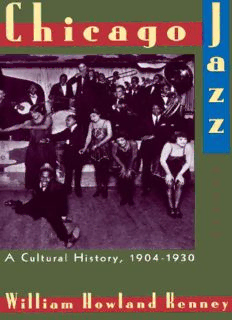
Chicago Jazz: A Cultural History, 1904-1930 PDF
Preview Chicago Jazz: A Cultural History, 1904-1930
Chicago Jazz This page intentionally left blank Chicago Jazz A Cultural History 1904-1930 WILLIAM-HOWLAND KENNEY NewY oOrkxford OXFORD UNIVERSITY PRESS Oxford University Press Oxford New York Athens Auckland Bangkok Bombay Calcutta Cape Town Dar es Salaam Delhi Florence Hong Kong Istanbul Karachi Kuala Lumpur Madras Madrid Melbourne Mexico City Nairobi Paris Singapore Taipei Tokyo Toronto and associated companies in Berlin Ibadan Copyright © 1993 by William Howland Kenney First published in 1993 by Oxford University Press, Inc., 200 Madison Avenue, New York, New York 10016 First issued as an Oxford University Press paperback, 1994 Oxford is a registered trademark of Oxford University Press All rights reserved. No part of this publication may be reproduced, stored in a retrieval system, or transmitted, in any form or by any means, electronic, mechanical, photocopying, recording, or otherwise, without the prior permission of Oxford University Press. Library of Congress Cataloging-in-Publication Data Kenney, William Howland. Chicago jazz : a cultural history, 1904-1930 / William Howland Kenney. p. cm. Includes bibliographical references and index. ISBN 0-19-506453-4 ISBN 0-19-509260-0 (pbk) r. Jazz—Illinois—Chicago—History and criticism. 2. Chicago (Ill.)—Social conditions, 3. Chicago (Ill.)—Race relations. 4. Chicago (Ill.)—Popular culture. I .Title. ML35o8.8.C5K46 1993 781.65*0973'1109042—dc20 92-27397 135798642 Printed in the United States of America For Francoise and Melanie This page intentionally left blank Acknowledgments MY INTEREST IN the cultural history of jazz was sparked by historian Neil Leonard many years ago at the University of Pennsylvania. In a small way at least, I hope this volume will indicate his enduring inspira- tion. The work of Lewis A. Erenberg deeply influenced my initial thoughts about a model for this study. Two Kent State University colleagues—Professors Doris Y. Kadish and August Meier—played im- portant roles by taking precious time from their own research to help me to improve the focus and organization of my chapter drafts. Their intel- lectual discipline and generosity have acted as a constant source of schol- arly inspiration, while their faith in this project's potential, like that of editor Sheldon Meyer, has been vastly encouraging. I gratefully acknowledge fellowship support for this book from the American Council of Learned Societies and the National Endowment for the Humanities. Both awarded summer Grants-in-Aid in 1989 for the collection of source materials in Chicago. The Research Council of Kent State University provided an Academic Year Research and Creative Ac- tivity Appointment in 1989 and travel funds to return to the archives thereafter. viii Acknowledgments The staffs of several libraries and archives, worked with remarkable skill to make my job easier. These organizations are listed on page 181.1 would particularly like to acknowledge, however, the permission granted by Ron Greek of the Columbia Oral History Collection and Mary Ann Bamberger of the University Library, University of Illinois at Chicago to quote from the collections under their management. Michael Cole, Linda Burroughs, and Mary Taylor of the Periodical Information and Access Department at Kent State did a skillful job of making available to me crucial interlibrary loan, periodical, and microfilm documents. I would also like to express my indebtedness to the dedicated jazz record collectors who went out of their ways to tape Chicago jazz records for my use. Joel O'Sickey again provided invaluable assistance in this regard, as he has on past projects, and I'm particularly grateful to him for sharing his considerable knowledge of the phonograph records with me. John and Nina Steiner offered me their hospitality while I learned from the Steiner Collection. Jim Stincic, John Richmond, Larry Booty, and John Bitter all provided records and tapes of Chicago jazz. Jazz guitarist Brad Bolton diagrammed some of the more complex big band record- ings. All these individuals proved the strength of the jazz community and the role it can play in helping to recreate a cultural history of jazz. Above all, Francoise Massardier-Kenney, who has shone a bright and encourag- ing light on my path to and through this project, has my heartfelt thanks. Kent, Ohio W. H. K. June 1992 Contents 1 • South Side Jazz: Cultural Context, 3 2 • The Evolution of South Side Jazz, 35 3 • White Jazz and Dance Halls, 61 4 • White Chicago Jazz: Cultural Context, 87 5 • Chicago's Jazz Records, 117 6 • "Syncopated Threnody": The End of Chicago's Jazz Age, 147 APPENDIX, 173 ABBREVIATIONS OF ARCHIVAL COLLECTIONS, 181 NOTES, 181 INDEX, 219
Description: